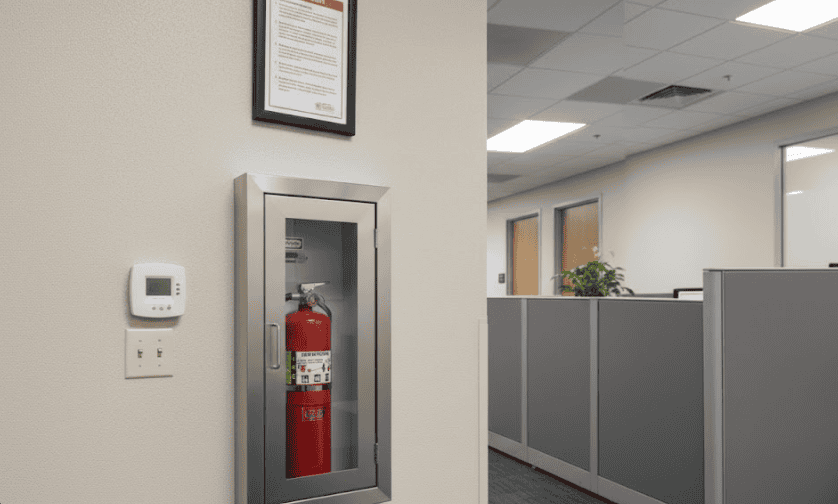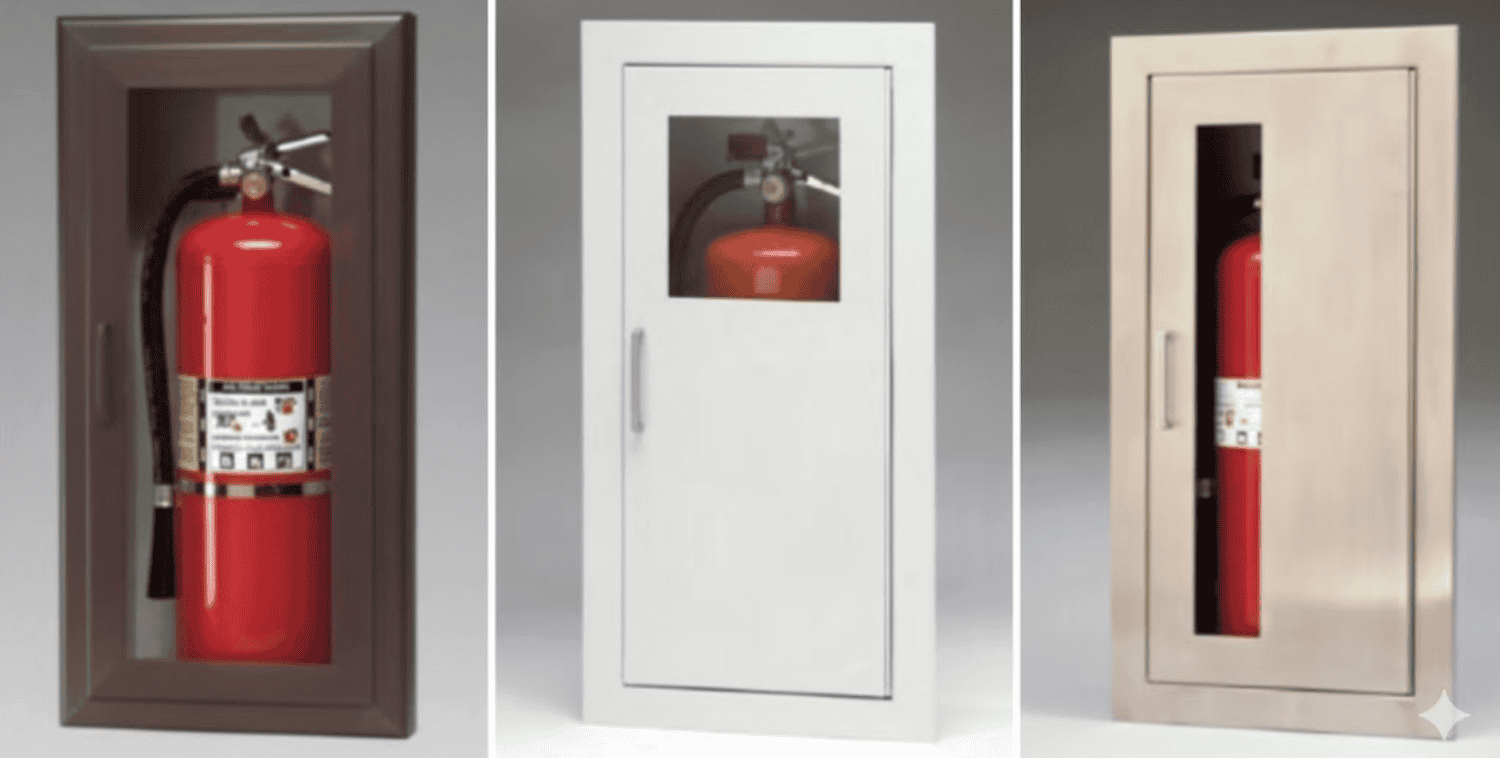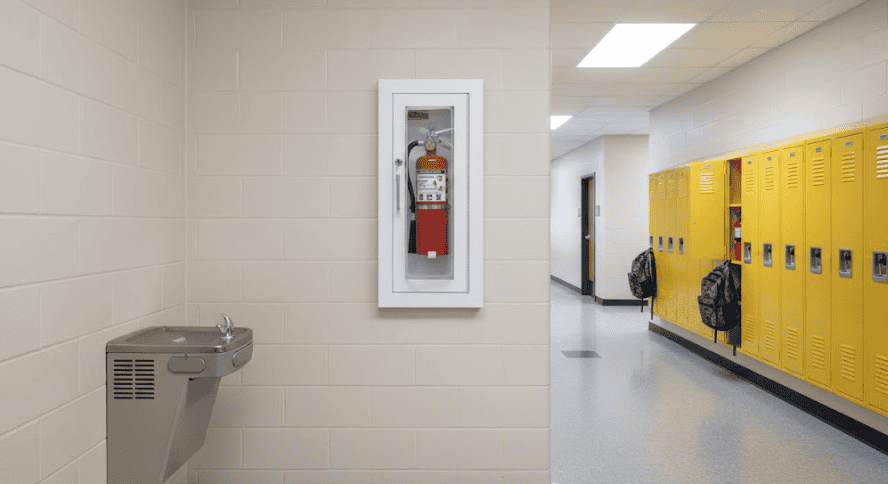Posted by Spycor LLC on Nov 10th 2025
The decision to purchase a fire extinguisher cabinet is rarely about simple aesthetics; it’s a non-negotiable step in achieving building code compliance, specifically under the NFPA 10 Standard for Portable Fire Extinguishers. For architects, facilities managers, and commercial contractors, selecting the wrong cabinet is not just a safety oversight—it's a critical financial liability that risks costly inspection failures and compromises occupant safety.
We are moving past the era of generic, poorly constructed storage solutions. Modern commercial and institutional design demands a solution that is durable, accessible, and seamlessly integrated. This guide focuses on the technical specifications and critical purchasing considerations that dictate compliance and longevity for your investment in premium Larsen Fire Extinguisher Cabinets and other high-quality enclosure systems.

Beyond Storage: Understanding Fire
Extinguisher Cabinet Compliance (NFPA &
ADA)
The most critical factor driving your cabinet choice is regulatory compliance. Ignoring these mandates, particularly those concerning accessibility and visibility, will lead to immediate inspection failure.
The NFPA 10 Mandate: Protection and Visibility
NFPA 10 requires fire extinguishers to be conspicuously located and readily accessible. A cabinet fulfills the "protection" element by shielding the extinguisher from physical damage, environmental corrosion, and vandalism, all while maintaining accessibility.
Key points that influence your cabinet selection:
- Mounting Height: The maximum height of the top of the extinguisher is typically determined by its weight, but generally, the operating instructions must be visible and legible. Crucially, the cabinet design must not obstruct the visual presence of the unit.
- Protection: The cabinet must be of a robust design (e.g., Stainless Steel or heavy-gauge Aluminum construction) to ensure the extinguisher is operational when needed.
- Locks and Access: While locks are often necessary in public or high-vandalism areas, they must be approved types that are easy to operate during an emergency. Break-glass panels and simple cylinder locks with quick-access emergency release mechanisms are industry standards for ensuring compliance without compromising security.
Navigating ADA Accessibility Standards
Accessibility requirements under the Americans with Disabilities Act (ADA) are where many installations fail. The cabinet must prevent the creation of a protruding object hazard in corridors and walkways.
The 4-Inch Rule: If an object is mounted on a wall between 27 inches and 80 inches above the finished floor, it cannot protrude more than 4 inches into a path of travel. This is the single most important factor when choosing between surface-mounted and recessed options.
- Recessed Fire Extinguisher Cabinets: These offer the cleanest, most compliant solution, as the cabinet box is fully installed within the wall cavity, leaving only the door and trim flush or nearly flush with the finished wall surface.
- Semi-Recessed Cabinets: These are a compromise for shallow walls, where the cabinet box extends partially into the wall and partially out. To comply with the 4-inch rule, the maximum projection from the wall must be four inches or less.
- Surface Mount Cabinets: These units are installed entirely on the wall surface. They must be installed below 27 inches from the floor (not typically practical for fire extinguishers) or be located outside of required circulation paths to avoid creating a protruding hazard.
Understanding this 4-inch rule is fundamental to specifying the correct Fire Extinguisher Cabinet type for your project’s environment.
Recessed, Semi-Recessed, or Surface
Mount? Matching Your Fire Extinguisher
Cabinets to the Wall
The structural decision of how the cabinet integrates with the wall is a core component of both architectural design and compliance. The choice hinges entirely on the existing or planned wall depth and the need for a clean aesthetic.
1. Recessed Fire Extinguisher Cabinets: The Seamless Look
The fully Recessed Fire Extinguisher Cabinets option is the preferred choice for new construction and whenever wall depth allows.
- Aesthetic Value: Provides the most architecturally clean installation, with the cabinet door typically flush with the wall surface. This minimizes visual clutter in high-traffic corridors.
- Compliance: Naturally complies with the ADA's 4-inch protrusion rule, making them the safest choice for installation in required circulation paths.
- Installation: Requires a standard 4-inch (or deeper) wall cavity for the cabinet tub.
2. Semi-Recessed Fire Extinguisher Cabinets: The Ideal Compromise
The Semi-Recessed option is a common solution when wall limitations prevent full recessing, but protrusion must still be minimized.
- Flexibility: Designed for use in shallower wall systems (e.g., in some existing buildings or specific non-load-bearing partitions).
- Compliance Bridge: Allows a portion of the cabinet to extend from the wall while the rest is concealed, achieving the necessary wall depth while maintaining the 4-inch ADA limit. Many Larsen Fire Extinguisher Cabinets offer trim options that specifically address the 4-inch protrusion requirement.
3. Surface Mount Fire Extinguisher Cabinets: Maximum
Durability, Specific Placement
The Surface Mount option is the simplest to install but requires careful placement planning due to the ADA protrusion rule.
- Ease of Installation: No wall modification is necessary; the cabinet is fastened directly onto the finished wall. This makes it ideal for masonry, concrete walls, or retrofits where cutting into the wall is impractical or prohibited.
- Use Case: Best suited for industrial environments, warehouses, or areas where the cabinet is placed out of the main path of travel (e.g., inside equipment rooms or in alcoves).
- Durability: Due to their robust back construction, surface-mount units often utilize stronger materials like heavy-gauge Stainless Steel to withstand external impact.
Durability Meets Design: Choosing the
Optimal Cabinet Material
A fire extinguisher cabinet must not only house the extinguisher but also withstand the specific environmental and aesthetic stresses of its location. The core material choice directly impacts longevity, fire rating, and visual integration.
Stainless Steel: The Standard for Cleanliness and Corrosion Resistance
For high-humidity areas, exterior locations, food preparation facilities, medical environments, or any space requiring maximum corrosion resistance, Stainless Steel Fire Extinguisher Cabinets are the superior choice.
- Longevity: Stainless steel resists rust and is exceptionally durable against chemical cleaning agents, maintaining its finish over decades of use.
- Aesthetics: Provides a sleek, modern finish that integrates well into contemporary commercial designs and high-end architectural specifications.
- Applications: Essential for marine environments, coastal buildings, hospital clean rooms, and institutional kitchens.
Aluminum: Light Weight and Cost-Effective
Aluminum Fire Extinguisher Cabinets offer a robust, lightweight, and cost-effective alternative to steel, particularly when weight is a factor or when a painted finish is desired.
-
Weight: Significantly lighter than steel, easing installation and reducing structural load in specific applications.
-
Finishing: Aluminum accepts high-quality powder-coat finishes easily, allowing for customization to match specific interior design palettes.
Fire-Rated Cabinets: Protecting Structural Integrity
In certain wall assemblies (like 1-hour or 2-hour fire-rated walls), the introduction of a cabinet opening can compromise the wall's fire rating. Fire Rated Cabinets are specifically designed to address this critical issue.
- Certification: These cabinets feature internal insulation, specialized fire-blocking materials, and often specific latching mechanisms to ensure the structural integrity and fire barrier properties of the wall remain intact for the specified duration (e.g., 1 hour, 2 hours).
- Mandate: If the wall you are installing into is a rated assembly, you must specify a compliant fire-rated cabinet. Specifying a standard cabinet in a fire-rated wall is an immediate code violation.
The Non-Negotiables: Essential Features
of High-Performance Cabinets
Beyond material and mounting type, the nuanced features of the door, glass, and hardware define a high-quality, high-performance unit. When investing in trusted brands like Larsen Fire Extinguisher Cabinets, you are ensuring these details are correctly specified.
Door and Glazing Options
The visibility of the extinguisher is a compliance requirement, leading to various glazing choices:
- Glazed Doors: The most common option, using materials like polycarbonate or tempered glass, offers full visibility of the extinguisher, simplifying identification and emergency access. Bubble or convex glazing can also be specified, offering a unique aesthetic while often accommodating larger extinguisher models in shallower wall cavities.
- Solid Doors: Often used in institutional or security-focused settings where the extinguisher must be fully protected from view or vandalism. These require clear, conspicuous signage on the door indicating the location of the fire extinguisher within.
Locking Mechanisms and Emergency Access
Security must not impede immediate access:
- Breaker Bars/Hammers: For cabinets with solid or locked doors, an attached hammer or breaker bar is essential for quick glass breakage in an emergency.
- Recessed Cylinder Lock: A standard, key-operated lock that secures the unit against casual theft or tampering. This should always be paired with an approved emergency access method unless the location is secured and under constant supervision.
- Continuous Hinges: High-quality cabinets feature continuous or piano hinges for increased strength and durability, preventing door sag and misalignment, especially for heavier Stainless Steel units.
Trim and Finish Quality
A high-quality cabinet uses trim that is both aesthetically pleasing and structurally sound.
-
Roll-Formed vs. Box Trims: Superior Larsen Fire Extinguisher Cabinets feature roll-formed or sculpted trims (architrave, classic, etc.) that provide a more architectural, finished look than simple bent-metal box trims. This detail significantly enhances the final appearance and perceived quality of the installation.
Conclusion: The Path to Guaranteed
Compliance and Quality
Choosing the correct fire extinguisher cabinet is a technical selection process driven by the strict mandates of NFPA 10 and ADA. You must align the installation type (Recessed, Semi-Recessed, Surface Mount) with the wall structure and ADA protrusion limits, and match the material (Stainless Steel, Aluminum, Fire-Rated) to the environmental conditions and fire-rating of the wall.
By prioritizing these specifications—and by selecting industry-leading, high-durability products like Larsen Fire Extinguisher Cabinets—you move beyond simple storage to guaranteed code compliance, architectural integrity, and unwavering long-term safety.
Order Now at spycor.com and explore the best NFPA-Compliant Fire Extinguisher Cabinets and Architectural Accessories to safeguard your facility and pass your next inspection with confidence.

FAQ:
What is the maximum protrusion allowed for a Fire Extinguisher Cabinet in an accessible path of travel?
According to ADA guidelines, objects mounted on a wall between 27 inches and 80 inches above the finished floor must not protrude more than 4 inches into a circulation path. This rule heavily favors Recessed or properly installed Semi-Recessed Fire Extinguisher Cabinets.
Do I need a Fire Rated Cabinet if I install it in a fire-rated wall?
Penetrating a fire-rated wall assembly (e.g., 1-hour or 2-hour rated) with a standard cabinet will compromise the wall's fire rating. You must specify a Fire Rated Cabinet that has been tested and certified for the specific fire rating of the wall to maintain code compliance and structural fire safety.
How do I ensure a locked Fire Extinguisher Cabinet is still accessible in an emergency?
A locked Fire Extinguisher Cabinet must employ an approved method for emergency access. The most common methods include using a break-glass panel (for quick, non-keyed access) or a cabinet that is equipped with an easily operated, non-key-requiring release mechanism (such as a simple latch or pull handle), or an emergency key located nearby in an approved location.
Are Larsen Fire Extinguisher Cabinets available in different trim styles?
Larsen Fire Extinguisher Cabinets are available with a variety of trim styles, including Architectural, Classic, and contemporary options. These different trims allow the cabinet to be aesthetically integrated with the surrounding architecture, whether you require a simple, flush finish or a more detailed, roll-formed profile.
Can I use a Surface Mount Fire Extinguisher Cabinet in a narrow hallway?
It is generally not recommended to use a Surface Mount Fire Extinguisher Cabinet in a narrow hallway or accessible path of travel because its full projection (often 6-10 inches) will typically violate the ADA's 4-inch protrusion limit. Recessed or Semi-Recessed options should be used in these areas to comply with accessibility codes.




